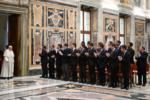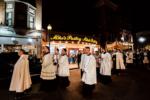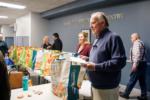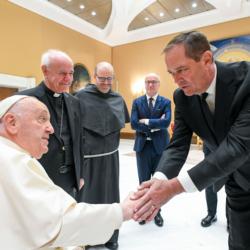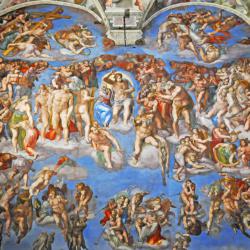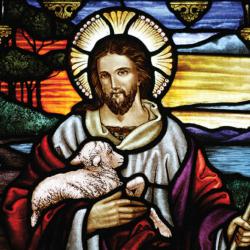Artist sees stained glass as a window to the divine
DORCHESTER -- In his 60 years of experience working with stained glass, Lyn Hovey has made a name for himself as a producer and restorer of church windows, aiming to help the viewer connect with the stories of the Gospels.
The founder of Lyn Hovey Studio, Hovey is an accomplished designer, painter, sculptor, and glazier. His work in stained glass and lighting includes both commissions of new art and the repair and restoration of existing pieces. Examples of his work can be found in churches, temples, schools, hospitals, and residential and commercial buildings. With studios in Dorchester and Antigua, Guatemala, as well as a partner in Taipei, Taiwan, his pieces can be found on multiple continents and across denominational divides.
The Archdiocese of Boston has been a frequent patron of Lyn Hovey Studio over the years. Hovey's restorations and original pieces can be found in Our Lady of Good Voyage in the Boston Seaport District and Bethany Chapel at the archdiocese's Pastoral Center in Braintree. He has also restored most of the windows at the Cathedral of the Holy Cross in Boston.
Speaking to The Pilot in April, Hovey said he is "deeply grateful" to the Catholic community.
"I wouldn't have been able to do what I've done without so many wonderful people I've met and worked with," he said.
Originally from the Cleveland area, Hovey studied at the Cleveland Institute of Art and served an apprenticeship in stained glass. He moved to Boston in 1965, and some religious sisters in Cambridge offered him a commission before he had even set up a studio.
Making stained glass is a labor-intensive process, usually requiring multiple assistants with training in both art and construction. Paper patterns are used to determine the size of each piece of glass in a project, similar to using patterns for making clothes.
Hovey explained that the most expensive color of glass is pink, which is made by mixing melted gold with the glass at its molten stage. Silver oxide is used to make yellow or amber-colored glass.
He said that this has made him develop his own symbology, with these colors representing divinity.
"If you're touching the robe of the Christ every now and then, when you have that moment through your work, and you realize the elements that you have to reach out to the Savior, and you know the materials you're using are gold and silver to turn this incredible pink, you begin to develop your own sense of a spiritual spectrum," Hovey said.
He said the "backbone" of his work has been what he calls "teaching windows," stained-glass windows for churches depicting moments in the Gospels.
"From those moments in the Savior's life come all these precious teachings and images and doorways into spirituality," Hovey said.
As he has gotten older, he said, he has felt less confined by tradition, and tries to "break out of the linear reality" and "add more dimensional spirituality."
"It's important to tell the story that, visually, one person would see if they were back 2,000 years ago with Christ. But the other thing that I'm shooting for is trying to catch the feeling of what it was like to be in the presence of the Savior," he said.
In addition to Catholic institutions, Hovey has also received commissions from Episcopal churches. He said he thinks that denominational differences begin to disappear as people journey closer to "the divine."
"People come to spirituality from different points of view sometimes, but there's a commonality as you get closer and closer to reaching the divine," he said.
For new projects, Hovey said, "the key is to be listening to hear what that community of faith is trying to share, with their congregation first and then with the world."
"It's very rich to have that ability to go between various communities of faith and hear their take on things and share what they want to emphasize if we're working on a project. My job is to listen and to try to reflect that in the works of art we create," Hovey said.
Many of his commissions are paid for by donors who want to leave something behind for future generations who attend their church. Sometimes they want to honor a loved one who has died by making a donation, dedicating a window, or even having the deceased depicted in a window.
Hovey recalled one project involving a family that had lost their son at age 13. They wanted a window depicting Jesus and the children, with the boy among them. Hovey also incorporated an image of the boy's older cousin, who had been ill throughout her life and had to use a wheelchair. The window showed her standing freely, something she had never been able to do. Hovey said the dedication of that window was one of the most intense services he has ever attended.
When asked about what inspires him, he said that art is "a way to celebrate the world around us."
"I think all artists are motivated by some inner drive that connects them to the world around them," Hovey said.
He thinks of it as "honoring the creation," and said the opportunity to touch it through art is "a strong motivator."
"Artists have that ability to feel like they're touching the divine through what they're doing," he said.



